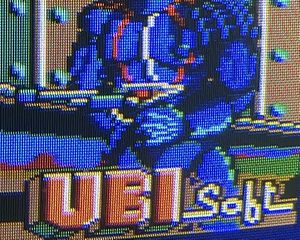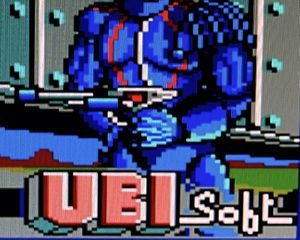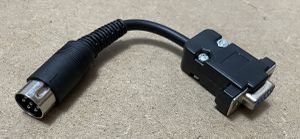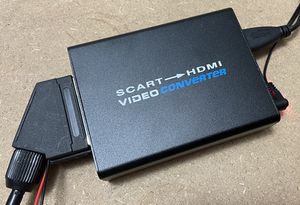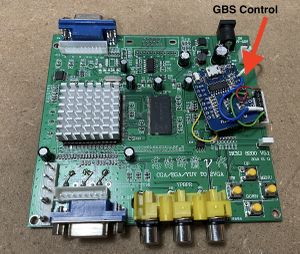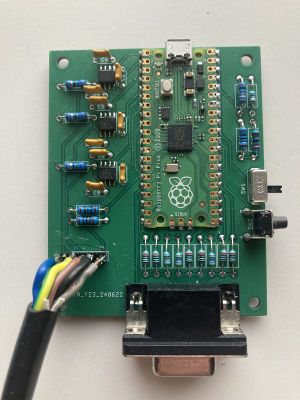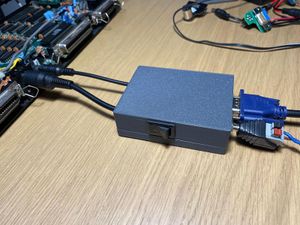Generally speaking, it's not too hard to connect the CPC to a modern LCD TV or monitor. Either the monitor already supports the CPC's signal directly, like TVs with SCART or RGB connector often do, or you can use one of the many converters that accept the RGB signal and convert it to a more modern signal, like VGA or HDMI.
If you are looking how to produce a Composite Sync signal, check LCD And Plasma TV Solution.
The Pitfalls of LCDs
One thing to keep in mind is, that there is yet no really perfect replacement for a CRT. There are mainly four issues, that will be different with an LCD.
Pitfall #1: power adapter
If you want to connect the CPC to anything but an Amstrad monitor you also need to provide a new power adapter, as the CPC does not have its own power adapter and relied on its original monitor. More information about this can be found in the article Power Supply for CPC and CPC plus.
Pitfall #2: Screen lag
Once you connect the CPC to a modern monitor, you may experience a phenomenon, that some games just don't feel right. It's like you are too slow - or that the collision detection seems to be off. Of course, some games are just crappy in that regard, or you might just get old ;-). But it's at least as likely, that your set-up has a significant screen lag. Screen lag means, that there is a significant delay between the moment that your CPC sends a signal to the monitor and the moment that this signal is shown on screen. Old school monitors don't have a significant screen lag. The CPC updates its screen 50 times per second, and any update will be visible almost instantly on a CTM644, GT65 or any other old school monitor with a tube. the reason for this is, that these monitors work analogue. They display the signals they receive immediately. As soon as there are any digital devices involved, this changes. Digital devices have some kind of chips that take the analogue signal and transform them into digital signals. This transformation requires some time and depending on the logic that is built in, this time is almost neglectable - or can be so significant, that it harms your gaming experience. A lag of 1 or 2 frames often does not do any harm, but any lag above one or two frames can be recognisable, at least in fast paced games which you are familiar with. You will see bullets still quite a distance away from you, but in the computer, the bullets have already hit you. You simply can no longer react fast enough, so this might be even THE most important aspect of your set-up.
(Note: Screen lag of course is not limited to games, but primarily there it can become a problem. If you want to measure the screen-lag of your set-up, there is a pretty easy way to do so, you just need your CPC, a mobile phone that can shoot videos at 120 or 240fps and a computer, to watch that video frame per frame. See: Testing your Screen-Lag with a CPC)
Pitfall #3: CRTC tricks
Not all demos and games will work if you are using an LCD. Games and demos that push the limit of the CPC, especially with CRTC tricks, might not work with a modern LCD. Relentless is a famous example, that (at the point of writing this article) will only work on real CRT monitors (or emulators of course). Although this sounds like a huge drawback, on a daily basis, it's not as bad. With the right set-up, except for a few exceptions like Relentless, all games and even most demos will work perfectly or in a way, that you don't experience problems.
Pitfall #4: pixel mask
(colour) CRTs have a pixel mask to produce red, green and blue from a single electronic beam. On a CRT there is no such thing as a sharp pixel. When you compare the same picture on a CRT and a LCD, you will see, that the picture on the CRT is much more blurry - but also smoother. It's personal preference if you like one more or the other. Or you don't bother. But some people would never replace their beloved CRT for an LCD, just because of the pixel mask.
How to connect to a modern LCD
The CPC monitor connector offers 3 lines for the colours red, green and blue, and one line for a composite sync (csync) signal, that combines horizontal and vertical sync. The horizontal frequency is 15.6Khz and the vertical frequency is 50Hz. In short: If your monitor supports RGB and these frequency values, you can use your monitor with a simple, passive adapter. If not, you need an active converter.
Options with passive adapters
LCD TV sets (SCART)
Many LCD TV sets offer a SCART connector, which often accepts the CPC signal directly. All you need is a CPC-to-Scart cable that you can either build yourself, or buy on Ebay for not too much money. Especially if you want a distinct monitor for your retro corner anyway, this can be a pretty nice and cheap solution. Used 15" camping TV sets have just the right size to feel comfortable and can be bought for a few bucks on Ebay or your local classifieds.
Your only enemy here is: screen lag. Some of the LCD TVs perform almost like CRTs, others seem to include a SCART2HDMI converter, and they have a bad lag (see below).
LCD computer monitors (VGA)
Some VGA LCD monitors are know to support the 15.6kHz frequency. These often can be connected with a simple DIN to VGA adapter. Screen lag of LCD monitors is usually very good and close to non-existing or half a frame max.
For most of them, all you need is to connect 5 pins of the CPCs 6pin DIN connector to the right pins of a VGA connector - and that's it.
A known example for a perfectly working monitor is the BENQ 702A. More examples can be found on the internet (see links below), but be aware, although the VGA standard should accept Csync on pin 13, some monitors expect separate v-sync and h-sync signals. In those cases, an adapter, that splits c-sync into h-sync and v-sync (CPC2VGA) would be required.
Converter options
There are plenty of active converters to connect retro computers and consoles to modern TVs and monitors. Their biggest difference is performance and price. And if you are not willing to do a bit of soldering, you probably will end up with either spending a lot of money - or getting a bad solution.
SCART to HDMI converters
SCART to HDMI converters are the cheapest and most simple solution. Make sure they (really) support RGB and not only composite video, like the cheapest SCART to HDMI converters usually do. RGB SCART converters start at around 30€ (2022). They will usually work and you will probably first think, that this is perfect, but they can add a hefty lag to your screen, some add up to 120ms (or 6 frames).
This Youtube video explains in detail why you should avoid Scart to HDMI converters for retro gaming.
It's fine if you only want to do a bit of BASIC programming or play adventures, but it could do some harm to fast action games.
Scan converters
Framemeister / OSSC
There are quite a few scan converters specifically built to connect many (all) retro computers and consoles to modern screens. The most famous ones are probably Framemeister and Open Source Screen Converter (OSSC). They are very flexible, have lots of options, zero or very low lag - and are really or quite expensive. Actually the only disadvantage they have is, that they are expensive. If you have a big retro collection, with several machines and consoles that you want to hook up to your LCD, then one of those might be the right choice. If not, there are cheaper, still great alternatives.
GBS8200 (VGA) / HD-VC9900 (HDMI)
These converters have originally been made to convert signals of arcade boards to modern LCD monitors via VGA (GBS8200) or HDMI (VC9900).
They do support the signal of the CPC but without any further modification, the conversion quality is limited. It adds up to 2 frames of lag, which might be just acceptable, but many famous games and demos won't work due to synching problems. All this improves a lot, once you add the GBS control mod to it. That's basically adding a microcontroller to the original board, that takes over control and adds features and flexibility that are close to the Framemeister and OSSC. Also the lag shrinks down to less than a frame, at least if your monitor does not add much lag on top.
See GBS Control for GBS8200 and VC9900
Especially the GBS8200 is easily available and incredibly cheap and if you know how to solder, the GBS Control mod is easy to do. And that's of course also the downside: you need to solder - and probably also 3D print a case for the GBS.
Update: Some sellers have adopted the GBS Control firmware and offer full products based on the GBS 8200 chipsets and the GBS Control mod. The price is a bit more than building one yourself - but still A LOT cheaper than any other (good) scaler solution. On the positive side it also already includes a case and HDMI output. Offers can be found e.g. on Amazon or AliExpress. Search for "GBS Control". No test has been docuemted so far with a CPC, so there's still a risk that the hardware behaves differently from a self-built GBS mod.
RGB2HDMI
The new star on the horizon. An open source project, that combines a Raspberry Pi with some custom logic, to convert signals from home computers and home consoles to HDMI. For almost every computer there is a more or less different version of the board. You can build the RGB2HDMI yourself or buy a finished version, e.g. on sellmyretro.com . It's features are even beyond those of the OSSC and Framemeister. Its total price is somewhere between the GBS and the OSSC, depending on where you buy it. And its tiny. Its biggest disadvantage is, that you need a different version of the board per console or home computer (well - some computers share a similar signal, so e.g. for the BBC you can also use the CPC version, but e.g. an Amiga or an Amstrad Plus each need another converter version). Screen lag has not been measured yet for it, but it seems to be very low.
vga4cpc
This DIY project by forum user gregg is based on the Raspberry Pico and (as of November 2024) the only solution that supports most (all?) CRTC tricks. Even games like Relentless that do not render properly on any of the other scan doublers are perfectly playable and absolutely smooth. Hardware and software are publicly available and the scan doubler can be built for less than €30 (€10-€30, depending on shipping costs for the parts). Assembly should be doable for anyone with average soldering skills.
Githup project: https://github.com/grzegorz-gr/vga4cpc
Forum thread: https://www.cpcwiki.eu/forum/amstrad-cpc-hardware/vga-through-rpi-pico-how-many-colors-possible-on-border/
The only downside would be that it only supports the Amstrad CPC, so if you own other computers (or even a Amstrad Plus or GX4000), you still need another solution.
Eto
Links
CPC Wiki
- How to - Scart cables
- LCD And Plasma TV Solution (Composite Video)
- Power Supply for CPC and CPC plus
External
